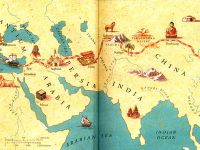
China’s mega project – the ‘One belt one road policy’ is slowly starting to work. Russia which is increasingly alienated from the west on the Ukraine issue is closing in more with Beijing for energy cooperation. Last May, President Putin has signed a $400 bn gas deal with China. Latest developments shows increased Chinese investment in the project which aims to bring huge gas reserves of Russian Siberia to the energy thirsty Chinese industrial belts.
The “One Belt and One Road” initiative was officially approved by the Chinese leadership and has got much momentum with in the recent party congress. The policy aims to build road, rail construction and sea route development to link China with the rest of the world. There are two components for it – the “Silk Road Economic Belt (SREB)” and “the Maritime Silk Road (MSR).”
Of these, the “One Belt” project envisages the construction of road and rail networks from the restive Chinese province of Xinjiang, going through Central and West Asia to Europe. The “One Road” is a maritime route through the Strait of Malacca to India, the Middle East and East Africa.
Overall, China envisages the reconstruction of the ancient Silk Route which provided big trade link between China with the rest of the world.
As part of the project, there will be a system of ports, railways and roads, to be built in different countries. China promises that the countries which cooperate with the project will get tremendous trade gains.
Some of these projects including one port in Sri Lanka are in construction mode; some others were completed or are being proposed.
The two projects will definitely enable China to diversify the routes by which it can secure the transport of oil and gas and other essential goods needed to sustain its economy.
Many important features of the project are yet to be evolved- like what will be the nature of Chinese military presence in the name of safety concerns in sea routes, funds to be provided to the participating nations to develop ports and use of the developed ports for trade with other countries etc. Some countries doubt the China centric nature of the project; though there are assurances from Beijing that partner’s benefit is essential part of the project.
Similarly, the project has many strategic and political dimensions than just economic significance. Double use of Chinese constructed projects (for military purposes) in Sri Lanka, Africa and in South China seas are going to invite concerns from regional players like India as well as from the US.
At present, the strong Russian cooperation in the project in the wake of the Ukraine crisis is an opportunity for China to show the rest of the world about the prospects of the one belt policy. Other participant countries who don’t like to get a troubled relationship with US and India are keenly watching the nature and progress of the China-Russia venture.










